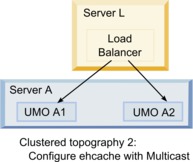Configure ehcache
The ehcache is an open
source Java™ distributed cache
for caching, Java EE, and light-weight
containers. Every node in the cluster can use the same plan_ehcache.xml file
or you can set a different plan_ehcache.xml file
for each node. For installations in a cluster, edit the plan_ehcache.xml file
so you do not have restart the computer if you make changes to templates
or offer folders.
Use one of the following procedures to configure the ehcache file.
Configuring ehcache with Remote Method
Invocation (RMI)
Marketing Operations systems that have the following topography typically use RMI:

Go to the <IBM_EMM_Home>\<MarketingOperations_Home>\conf directory and open the plan_ehcache.xml file in a text editor. Then, make the following edits:
Uncomment the following section of the file.
You must customize the items that are shown in bold (machineA, machineB, and port) to reflect your environment. Provide a pipe-separated list of all machines in the cluster, by using fully qualified host names.
<!-- <cacheManagerPeerProviderFactory class="net.sf.ehcache.distribution.RMICacheManagerPeerProviderFactory" properties="peerDiscovery=manual, rmiUrls=//<ServerA>:40000/planApplicationCache|//<ServerB>: 40000/planApplicationCache"/> <cacheManagerPeerListenerFactory class="net.sf.ehcache.distribution.RMICacheManagerPeerListenerFactory" properties="port=40000, socketTimeoutMillis=20000"/> -->- Uncomment the following section of the file.
<!-- <cacheEventListenerFactory class="net.sf.ehcache.distribution.RMICacheReplicatorFactory" properties="replicateAsynchronously=true, replicatePuts=true, replicateUpdates=true, replicateUpdatesViaCopy=true, replicateRemovals=true"/> <cacheEventListenerFactory class="com.unicacorp.uap.common.cache.PlanCacheEventListenerFactory "net.sf.ehcache.distribution.RMIBootstrapCacheLoaderFactory" /> --> - If the following lines are present in the file, remove them.
<bootstrapCacheLoaderFactory class=net.sf.ehcache.distribution. RMIBootstrapCacheLoaderFactory"/>
Configuring ehcache with multicast
Marketing Operations systems that have the following topography typically use multicast:

Go to the <IBM_EMM_Home>\<MarketingOperations_Home>\conf directory and open the plan_ehcache.xml file in a text editor. Then, make the following edits:
Uncomment the following section of the file.
You must customize the items that are shown in bold (multicastGroupAddress and multicastGroupPort) to reflect the multicast group and port in your environment.
<!--<cacheManagerPeerProviderFactory class="net.sf.ehcache.distribution.RMICacheManagerPeerProviderFactory" properties="peerDiscovery=automatic, multicastGroupAddress=230.0.0.1, multicastGroupPort=4446, timeToLive=32"/> <cacheManagerPeerListenerFactory class="net.sf.ehcache.distribution.RMICacheManagerPeerListenerFactory"/> -->- Uncomment the following section of the file.
<!-- <cacheEventListenerFactory class="net.sf.ehcache.distribution.RMICacheReplicatorFactory" properties="replicateAsynchronously=true, replicatePuts=true, replicateUpdates=true, replicateUpdatesViaCopy=true, replicateRemovals=true"/> <cacheEventListenerFactory class="com.unicacorp.uap.common.cache.PlanCacheEventListenerFactory" /> --> - If the following lines are present in the file, remove them.
<bootstrapCacheLoaderFactory class="net.sf.ehcache.distribution.RMIBootstrapCacheLoaderFactory"/>
